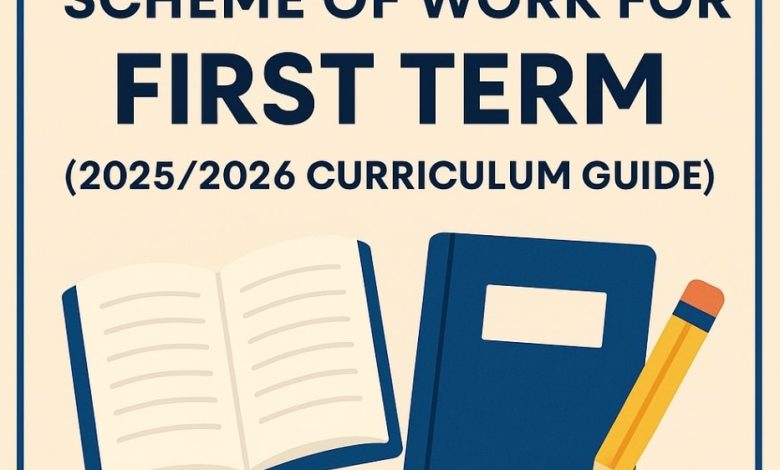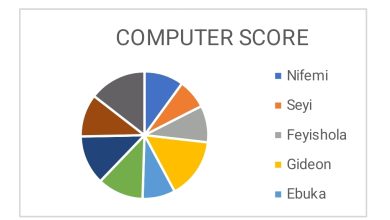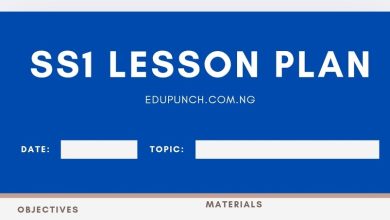SS1 English Language Scheme of Work for First Term (2026/2026 Curriculum Guide)

Discover the complete SS1 English Language Scheme of Work for First Term, aligned with Nigeria’s 2025/2026 curriculum. Includes weekly lesson topics, grammar focus, essay writing, and comprehension skills. It’s ideal for teachers, students, and parents preparing for academic success.

Read Also: SS1 English Exam Questions- First Term
SS1 English Language Scheme of Work
| Week | Topic | Objectives |
| 1. | a) Oral: Review of Sounds | i. Differentiate between English Letters of the alphabets and English Sounds.
ii. Identify letters of the alphabets that have corresponding sounds and symbols. iii. Relate sounds in words with the symbols that represent them. |
| b) Structure: Review of Word classes
C) Comprehension: Reading to comprehend main ideas.
D. Vocabulary Development: Words Associated with Home Family Life
|
i. List all the parts of speech
ii. Use nouns, verbs, prepositions, adjectives and conjunctions in sentences. iii. Classifies words in a given passage into word classes.
1. Identify the topic sentencein each paragraph 2. Establish the relationship between the topic sentences and the main ideas in a given passage. 3. Attach contextual meanings to new words found in a given passage.
i. Draw out from a given text word associated with Home and Family life. ii. Explain the words associated with home and family life iii. Compose short composition on the family. |
|
| 2. | (a) Oral: Monophthong
(a) |
1. List and explain the functions of the organs of speech
2. Distinguish between long and vowel sounds. 3. Identify and pronounce vowel sounds in English words appropriately. |
| (b) Structure: Nouns- Meanings and Types | 1. Recognize nouns in sentences
2. give adequate example of all types of nouns 3. Compose different sentences using different types of nouns. |
|
| (c) Comprehension: contextual meaning | 1. Differential between contextual and literal meaning
2. Give other words to replace the words in italic in a given passage. 3. Specify the class of the words. 4. Recognize when such words are used in other contextual situations. |
|
| (d) Writing: Composition
On “My Family” |
1. breakdown a sample essay into its constituent parts
(introduction, body and conclusion) 2. Analyze the pattern of sentence structure used in the sample essay, develop a well written essay on my family. |
|
| 3 | (a) Oral : Diphthongs | 1. Identify diphthongs sounds and their phonetics symbols
2. Match diphthong sounds with the symbols that represent them; practice with words/sentences that have diphthong sound in them. |
| (b) Structure: Countable and uncountable nouns | 1. Distinguish between countable and uncountable nouns with adequate examples.
2. Form the singular and plural of countable nouns and use them correctly in a sentences. 3. Create a list of uncountable nouns (nouns without plural forms). |
|
| (c) Composition: Reading to comprehend supporting details | 1. Identify supporting ideas in each paragraph
2. Differentiate between main ideas and supporting ideas in a given passage 3. Recognize words that signal detail/illustrations and examples in a given passage. |
|
|
|
(d) Vocabulary developments: register of Agriculture | 1. List words that associate with crops farming activities and implements
2. Write an essay on the importance of farming |
| 4 | (a) Oral Triphthong | 1. Identify the 5 oral Triphthong sound and the their phonetic symbols
2. Give adequate examples of words that contain triphthong sounds 3. Pronounce words that contains these sounds correctly. |
| (b) Writing: Essay
A. Types, narrative B. ‘A place of interest I visited’
© Structure: Adjectives and Adverbs |
1. Mention and explain each type of essay;
2. List places of interest they had visited 3. Write a narrative essay on the places of interest you visited.
1. Explain adjectives and adverbs 2. Give examples of types of adverbs and adjectives. 3. Compose different sentences using, using adjectives and adverbs. |
|
| 5 | (a) Oral: consonant sounds e.g/p/, /b/,/t/, /d/, /k/, /g/, /f/, /v/, /s/, /z/ | 1. Recognize and pronounce the listed sound correctly;
2. Identify the listed position in different position in words 3. Generate tens of words on each of the listed sounds. |
| (b) Structure: phrase types and functions
|
1. Explain phrase
2. Mention the types of phrase 3. Analyse of (a) Noun phrase (b) Adverbial phrase (c) Adjectival phrase (d) prepostionnal phrase and from examples. C. |
|
| (C) Vocabulary development: fishery and animal husbandry | 1. Explain following terms fishery animal husbandry
2. List words that are associated with Animal husbandry |
|
| (d)Comprehension:
Emphasis on supporting details tone, mood and purpose |
1. Identify a speaker’s/writer’s tone in a text to bring out its mood and purpose
2. Relate the issue raised in the text to their real life experience. |
|
| 6 | (a) Structure:
A. Clause: types- Main clause Subordinate B. Types of subordinate clauses.
|
1. Explain what a clause is;
2. Analyze complex sentences into main and subordinate clauses 3. Give copious examples of sentence that contain the two type of clauses. |
| (a) Comprehension reading to make notes. | 1. Identify topic sentences in a text
2. Differentiate between main idea and supporting idea in a given passage |
|
| (b) Vocabulary development | 1. Recognize easily confused words in English;
2. Highlight the differences between/among them; 3. Use the easily confused words in different contexts correctly. |
|
| (c) Writing: Descriptive farming in my village or town.
How to make a local dish or any other related topic. |
1. Highlight the features of a descriptive essay
2. Develop an outline for a descriptive essay 3. Write a descriptive essay on either of the following; farming in my village. |
|
| 7 | Mid-Term Break/Open Day | |
| 8 | (a) Oral: syllable on two/three/four syllable words. | 1. Divide words into syllables with adequate examples
2. Apply the principles guiding stress placement on syllables in words 3. Pronoun words appropriately with the light syllables stressed. |
| (b) Structure: sentences types according to structure, according to function | 1. Define a sentence
2. Discuss all types of sentences and give adequate examples. 3. Analyze a text to identify and classify the sentence into types. |
|
| (c) Composition: reading introduction to answering comprehension question | 1. Draw inferences from passages
2. Differentiate between main ideas and supporting idea in a given passage 3. Replace the new words with their equivalents |
|
| (d)Writing: letter writing types of letter informal features formats | 1. list types of letters
2. Discuss the features of informal letter. 3. Write a letter to a close relative or a friend in another town. |
|
| 9 | (a) Oral: Syllable and stress
Stress on the first syllable
|
1. Explain what a syllable is;
2. Explain the meaning of stress 3. Identify words that have stress on the first syllable 4. Pronounce words that have stress on the first syllable correctly. |
| (b) Structure: regular and irregular verbs | 1. Explain the terms regular and irregular verbs.
2. Distinguish between regular and irregular verbs 3. Construct sentences using regular and irregular verbs.
|
|
| (c) Comprehension: summary | 1. Explain what summary is;
2. state the dos and don’ts of summary writing; 3. Summarize a given passage |
|
| (d)Writing: letter writing. Formal letter writing features, format. | 1. distinguish between formal and informal letters
2. state the features of a formal letter 3. write the format of a formal letter 4. Write a letter of complaint to the chairman of your local government area on the problem of insecurity. |
|
| 10 | (a) Structure: figure of speech | 1. Explain the following terms: simile, metaphor, irony, personification, hyperbole, synecdoche, paradox, pun;
2. give adequate example of each of the slated figures of speech; 3. Recognize the figures of speech in any given passage. |
| (b) Comprehension: | 1. Explain the terms:
a) inference b) deduction 2. infer the appropriate answers using their own expression |
|
| (c) Writing: Argumentative Essay: “Women have same opportunities in life as men.” Or any other topical topic. | 1. Describe characteristics of an argumentative essay;
2. Explain elements of argumentative essay. 3. Demonstrate understanding of argumentative essay format. |
|
| (d) Vocabulary development: words associate with library | 1. Explain the importance of a library;
2. List all items that can be found in a library environment. |
|
| 11 | (a) Structure: definite and indefinite article | 1. give example of definite and indefinite articles;
2. Distinguish between definite and indefinite articles. 3. Use definite and indefinite article in sentences.
|
| (b) Vocabulary development: words associated with journalism | 1. Explain what journalism is;
2. give copious examples of words associated with journalism/press/media; 3. State the importance of journalism to the state/nation. |
|
| (c) Oral: Dialogue on the experience of national/topical issues | 1. Have a robust dialogue with classmates on any given topical issues. | |
| (d) Write: Review of essay writing | 1. Distinguish between argumentative and narrative essays;
2. give a talk on the topic: Boys are more useful at home than girls; 3. Narrate a story that ends with “A patient dog eats the fattest bones”. |
|
| 12 | Revision | Revise |
| 13 | EXAMINATION | |
| 14 | EXAMINATION |
To get complete lesson notes, kindly contact Us. So we can send the Doc formats to you.





2 Comments